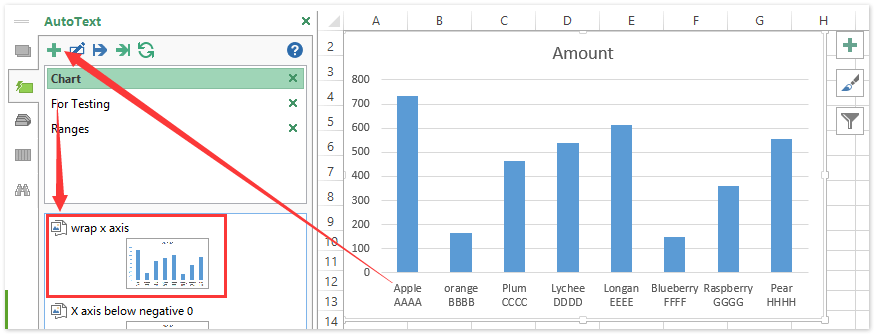

From the Categories list, select Scale > The Format Axis dialog box refreshes to display the Scale options > To change the minimum value of the y-axis, in the Minimum text box, type the minimum value (1.0) you want the y. So if you enter "three" into this box, the first, fourth, seventh and tenth - continuing until you run out of labels - display.Ĭlick on the text box next to "Interval between tick marks." Enter the same number as your interval unit if you only want Excel to show a tick on the axis when it displays a label. Make sure that interval between the labels is set to 1 point in the vertical axis. The first axis label displays, then Excel skips labels until the number of your interval, and continues on in this pattern. Type in the interval that you want to use for the X-axis labels. The Format Axis window appears.Ĭlick on the radio button next to "Specify interval unit," then place your cursor into the small text box next to the button.

Click the "Format Selection" button next to the drop-down arrow to continue.
#EXCEL GRAPH AXIS LABEL TEXT SERIES#
In the formula bar, you will see there is a formula like this: SERIES (,Sheet1M10:M15,2) Note that the X range (between the first two commas) is missing. Right-click the value axis labels you want to format.Click on the "Layout" tab at the top of the Excel window, then click the drop-down arrow on the left side of the ribbon and choose "Horizontal (Category) Axis" from the list of options. It doesnt really matter if your X axis values are formatted as text or not. To change the format of numbers on the value axis: On the Character Spacing tab, choose the spacing options you want. One common change is to add or edit Axis labels. Under 'General', 'Alignment', choose 'Right' or 'Left' from the drop-down menu. Select the arrow at the bottom right of the paragraph section on the ribbon to bring up the Paragraph dialog box. On the Font tab, choose the formatting options you want. However, at times youll find you need to adjust the settings to get your chart looking the way you want. Here is the desired right aligned text: What to do: Paste the chart in Word or PowerPoint and select the Y axis labels (click on any part of the text). Right-click the category axis labels you want to format, and click Font. In the options window, navigate to Select Data to change the label axis data. To change the format of text in category axis labels: Right-click the graph to options to format the graph. Change the format of text and numbers in labels In the Axis label range box, enter the labels you want to use, separated by commas.įor example, type Quarter 1 ,Quarter 2,Quarter 3,Quarter 4. In the Horizontal (Category) Axis Labels box, click Edit. Right-click the category labels you want to change, and click Select Data. To keep the text in the source data on the worksheet the way it is, and just create custom labels, you can enter new label text that's independent of the worksheet data: Type the text you want in each cell, and press Enter.Īs you change the text in the cells, the labels in the chart are updated. Your chart uses text from its source data for these axis labels.ĭon't confuse the horizontal axis labels-Qtr 1, Qtr 2, Qtr 3, and Qtr 4, as shown below, with the legend labels below them-East Asia Sales 2009 and East Asia Sales 2010.Ĭlick each cell in the worksheet that contains the label text you want to change. In a chart you create, axis labels are shown below the horizontal (category, or "X") axis, next to the vertical (value, or "Y") axis, and next to the depth axis (in a 3-D chart). Excel for Microsoft 365 Word for Microsoft 365 Outlook for Microsoft 365 PowerPoint for Microsoft 365 Excel 2021 Word 2021 Outlook 2021 PowerPoint 2021 Excel 2019 Word 2019 Outlook 2019 PowerPoint 2019 Excel 2016 Word 2016 Outlook 2016 PowerPoint 2016 Excel 2013 Word 2013 Outlook 2013 PowerPoint 2013 More.


 0 kommentar(er)
0 kommentar(er)
